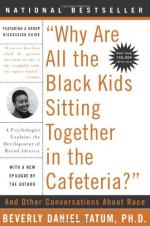
|
| Name: _________________________ | Period: ___________________ |
This test consists of 5 short answer questions, 10 short essay questions, and 1 (of 3) essay topics.
Short Answer Questions
1. The second manifestation of the KKK flourished nationwide in what era?
2. What is the third of five stages that whites pass through in dealing with race, according to the author in Part III, Understanding Whiteness in a White Context, Chapter 6, The Development of White Identity?
3. What is the first of five stages that whites pass through in dealing with race, according to the author in Part III, Understanding Whiteness in a White Context, Chapter 6, The Development of White Identity?
4. What is a system in which descent is traced through the mother and maternal ancestors?
5. When was Assimilation Blues: Black Families in a White Community published?
Short Essay Questions
1. What stages of white identity development does the author describe in Part III, Understanding Whiteness in a White Context, Chapter 6, The Development of White Identity?
2. How does the author suggest that Whites deal with their struggle with Whiteness positively in Part III, Understanding Whiteness in a White Context, Chapter 6, The Development of White Identity?
3. How does the author introduce the concept of affirmative action in Part III, Understanding Whiteness in a White Context, Chapter 7, White Identity and Affirmative Action?
4. How does the author describe the similarities and variations within the Native American community in Part IV, Beyond Black and White, Chapter 8, Critical Issues in Latino, American Indian, and Asian Pacific American Identity Development?
5. How does the author suggest we as individuals seek the courage to open racial dialogues in Part V, Breaking the Silence, Chapter 10, Embracing a Cross-Racial Dialogue?
6. What is the author's conclusion about forming racial identity within minority groups in Part IV, Beyond Black and White, Chapter 8, Critical Issues in Latino, American Indian, and Asian Pacific American Identity Development?
7. What are the advantages of affirmative action, according to the author in Part III, Understanding Whiteness in a White Context, Chapter 7, White Identity and Affirmative Action?
8. How does Tatum describe the development of white identity in Part III, Understanding Whiteness in a White Context, Chapter 6, The Development of White Identity?
9. When and how does Tatum describe the need for racial consciousness in biracial children in Part IV, Beyond Black and White, Chapter 9, Identity Development in Multiracial Families?
10. How does the author assert whites learn about racism in Part III, Understanding Whiteness in a White Context, Chapter 6, The Development of White Identity?
Essay Topics
Write an essay for ONE of the following topics:
Essay Topic 1
Define and analyze the terms individualism, meritocracy, "normal," and "the other." How are these terms applied to social studies and psychology?
Essay Topic 2
Describe William Cross and the five stages of "nigrescence." When did Cross develop his theories of racial development?
Essay Topic 3
Discuss the period of history when the author studied at university and the racial climate in America during this time. How did this affect the author's racial identity development?
|
This section contains 979 words (approx. 4 pages at 300 words per page) |

|




